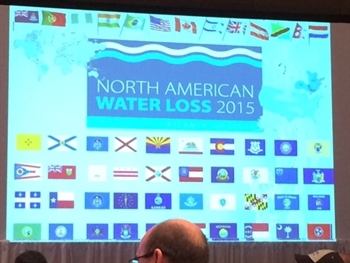
Flickr user Erin Nekervis (CC)
In 2008, this stretch of Montrose Avenue on Chicago's North Side collapsed due to a water main break.
No one wants water infrastructure to fail.
Images of collapsed streets with semi-submerged cars and flooded buildings due to burst pipes are disconcerting, and becoming more commonplace in our built environment. Some of us may remember the water main break in Chicago on Jan. 22, 2008, when a 70-foot section of Montrose Avenue collapsed to reveal the ubiquitous infrastructure required to keep our communities humming. This water infrastructure failure crippled street and pedestrian traffic and impacted businesses for weeks.
Making sure the pipes that deliver us water are in good condition is critical to our safety, health and everyday lives.
Which is why I want to share with you two exciting events that occurred over the past two weeks in the world of water—both of which point toward progress in tackling the crumbling water infrastructure issue that plagues all our communities.
First, on Thursday, Dec. 3, 2015, Congress passed legislation that will lift a ban on the use of tax-exempt bonds in conjunction with loans received from the Water Infrastructure Finance and Innovation Act (WIFIA).
Let’s unpack that for a minute: what this means is that use of WIFIA funding would now allow water service providers to put together more attractive financing for potential investors at a reduced borrowing cost to the communities they serve. A win-win.
Municipal bonds in the U.S. can be issued by a state, county or municipality in order to finance capital expenditures (such as water pipes, pumps, etc.), and are exempt from federal taxes. Tax-exempt means the borrower pays no federal income tax on the interest earned, and the issuer (like a public water utility) generally pays a lower interest rate to borrow the funds to finance needed infrastructure.
Enacted in June 2014 as part of the Water Resources Reform and Development Act, WIFIA established a new, low-interest financing mechanism for up to 49 percent of the price tag for high-cost water, wastewater, stormwater and water reuse infrastructure projects. The creation of WIFIA signaled an important message nationally—our water service infrastructure needs reinvestment because it serves a vital role in the health and prosperity of our communities.
However, as the law was first written, WIFIA prohibited tax-exempt bonds from funding the remaining 51 percent of a project, a logic which defied most industry experts, and as a result took away a cost-effective tool that greatly undermined the potential use of WIFIA for communities in need of viable financing options for their water infrastructure reinvestment needs.
The water industry and its advocates consider removing this ban in the law a huge step forward. Now we just need Congress to appropriate funds for WIFIA…no rest for the weary!
The second exciting event that occurred was the inaugural North American Water Loss Control conference (NAWL15), which took place in Atlanta, Ga., in the first week of December 2015. Conference organizers hoped for 200 attendees and got over 500 from fifteen countries, with more than 40 North American states and provinces represented.
The sole topic of the conference was best practices for fixing our crumbling infrastructure and reducing water loss in our supply pipes. It was a premier assemblage of policy and technical experts training water managers and operators on best practices to prevent events such as the Montrose Avenue street collapse from happening.

Danielle Gallet
Outstanding attendance for NAWL's inaugural conference.
This conference and the outstanding level of participation represents a turning point in the water industry—we are getting our utility houses in order. I have to say it was quite thrilling to be a part of such a groundswell of utilities, regulators, industry consultants, manufacturers and advocates working diligently to ensure all water systems continue to keep our faucets working for us.
Both of these events mark beneficial progress in attending to our nation’s water infrastructure, which is good because we have some infrastructure to reinvest in if we want to prevent future water pipes from bursting and causing chaos. Here in Illinois it is estimated it will take around $32 Billion to get our water supply and wastewater infrastructure into good, working order.
That’s a lot of money. But dedication from state, local, federal and even international actors represents a pivot in the right direction. Now let’s start walking.